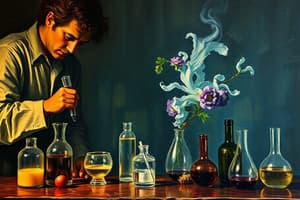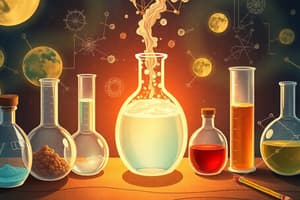Podcast
Questions and Answers
What is the role of a control group in an experiment?
What is the role of a control group in an experiment?
- To manipulate the outcomes of the study
- To provide a standard for comparison against the experimental group (correct)
- To change the independent variable
- To be the primary focus of the experiment
What is calculated to determine the total magnification of a microscope?
What is calculated to determine the total magnification of a microscope?
- The product of the objective and ocular lens magnifications (correct)
- The sum of the objective and ocular lenses
- The average of the magnifications of all lenses used
- The difference between the objective and ocular lens powers
Which of the following is NOT a part of preparing a wet mount slide?
Which of the following is NOT a part of preparing a wet mount slide?
- Using a cover slip to prevent air bubbles
- Placing a specimen in a drop of liquid
- Observing the slide under a microscope
- Applying a heat source to dry the slide (correct)
What should be done to avoid damaging a microscope during use?
What should be done to avoid damaging a microscope during use?
What distinguishes a dependent variable from an independent variable in an experiment?
What distinguishes a dependent variable from an independent variable in an experiment?
Which statement correctly describes a control group in an experiment?
Which statement correctly describes a control group in an experiment?
What is a potential consequence of not maintaining constants in an experiment?
What is a potential consequence of not maintaining constants in an experiment?
How is the focus of a specimen adjusted when using a microscope?
How is the focus of a specimen adjusted when using a microscope?
Which of the following best describes the process of making a wet mount?
Which of the following best describes the process of making a wet mount?
Which factor is NOT typically considered as an independent variable in scientific experiments?
Which factor is NOT typically considered as an independent variable in scientific experiments?
What might happen if a microscope is not properly maintained during use?
What might happen if a microscope is not properly maintained during use?
Flashcards are hidden until you start studying
Study Notes
Hypothesis vs. Question
- A hypothesis is a testable prediction or explanation about a phenomenon.
- It is a specific statement that can be tested through experiments.
- A question is a broader inquiry that may not be directly testable.
Independent Variable
- An independent variable is a factor that is changed or manipulated by the experimenter.
- It is the presumed cause in the experiment.
Dependent Variable
- A dependent variable is the factor that is measured or observed in an experiment.
- It is the presumed effect in the experiment.
Control Group vs. Experimental Group
- A control group is a group that does not receive the treatment or manipulation being studied.
- An experimental group receives the treatment or manipulation.
- This allows researchers to compare the results of the control group to the experimental group to see if the treatment had an effect.
Constants
- Constants are factors that are kept the same or controlled for in an experiment.
- This helps ensure that any observed changes in the dependent variable are due to the independent variable, not other factors.
Parts of a Microscope
- Eyepiece: The lens you look through to view the specimen.
- Objective Lenses: Lenses that magnify the specimen, usually have different magnifications.
- Stage: The platform where the slide with the specimen is placed.
- Condenser: Focuses light onto the specimen.
- Diaphragm: Controls the amount of light that passes through the condenser.
- Light Source: Provides illumination for viewing the specimen.
- Fine Adjustment Knob: Used for precise focusing.
- Coarse Adjustment Knob: Used for initial focusing.
- Base: The bottom of the microscope, provides stability.
- Arm: Connects the base to the body tube.
Calculating Magnification
- Magnification of a microscope is determined by multiplying the magnification of the eyepiece by the magnification of the objective lens being used.
- Example: If the eyepiece has a magnification of 10x and the objective lens has a magnification of 40x, the total magnification is 10x * 40x = 400x.
Focusing a Specimen
- Start with the lowest objective lens.
- Use the coarse adjustment knob to bring the specimen into rough focus.
- Then switch to a higher objective lens.
- Use the fine adjustment knob to bring the specimen into sharp focus.
Creating a Wet Mount
- Place a drop of water on a clean slide.
- Place the specimen in the water drop.
- Carefully lower a coverslip over the specimen at an angle to avoid air bubbles.
Avoiding Damage to the Microscope
- Always carry the microscope with two hands (one hand under the base and the other holding the arm).
- Clean the lenses with lens paper after each use.
- Use only proper cleaning solutions for lenses.
- Avoid touching the lenses with your fingers.
- Do not force the knobs or adjust the microscope in a way that might break it.
- Properly store the microscope in a dust-free environment.
Hypothesis vs. Question
- A hypothesis is a testable prediction that can be proven or disproven.
- A question is an inquiry seeking information or understanding.
- A scientific question can be answered by an experiment
Independent Variable
- The factor that is changed or manipulated by the experimenter.
Dependent Variable
- The factor that is measured or observed in an experiment. It is affected by the independent variable.
Control Group
- The group that does not receive the treatment or manipulation of the independent variable. It serves as a baseline for comparison.
Experimental Group
- The group that receives the treatment or manipulation of the independent variable. It is compared to the control group to determine the effect of the independent variable.
Constants
- Factors that are kept the same or unchanged throughout an experiment.
- They help ensure that any observed differences in the dependent variable are due to the independent variable and not other factors.
Microscope Parts
- Eyepiece: The lens you look through, typically 10x magnification.
- Objective Lenses: Multiple lenses with varying magnifications, mounted on a revolving nosepiece.
- Stage: Platform where the slide is placed.
- Stage Clips: Devices used to hold the slide securely in place.
- Diaphragm: Controls the amount of light passing through the specimen.
- Light Source: Provides illumination for viewing the specimen.
- Coarse Adjustment Knob: Moves the stage up and down for initial focusing.
- Fine Adjustment Knob: Used for precise focusing.
- Base: The stable bottom of the microscope.
- Arm: Supports the eyepiece and objective lenses.
Calculating Magnification
- Magnification = Eyepiece Magnification x Objective Lens Magnification
- Example: If the eyepiece is 10x and the objective is 40x, then the total magnification is 400x.
Focusing a Specimen
- Start with the lowest power objective lens (usually 4x).
- Use the coarse adjustment knob to move the stage up or down until the specimen is roughly in focus.
- Use the fine adjustment knob to make the image sharper.
- If necessary, switch to higher power objectives and refocus using only the fine adjustment knob.
Wet Mount Preparation
- Place a drop of water or other liquid on a slide.
- Gently place a coverslip over the drop, avoiding air bubbles.
Microscope Safety
- Always carry the microscope with one hand on the arm and the other hand supporting the base.
- Do not touch the objective lenses with your fingers, as this can damage them.
- Use lens paper to clean the lenses.
- Never force the stage or knobs.
- Turn off the light source when finished.
Studying That Suits You
Use AI to generate personalized quizzes and flashcards to suit your learning preferences.




